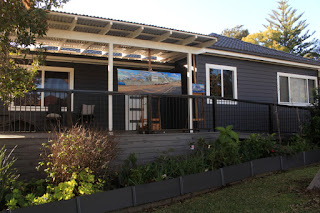I'm caring for my elderly and very frail mum at home, so even when restrictions are relaxed, my obligations as a carer mean I'll still be very restricted in the amount of plein air painting I can do.
I've used my enforced downtime to repair old paintings. When canvases are taken to exhibitions and handled a lot they can get scuffed at the edges.
I'd spent the start of the Covid season putting up a pergola over the front deck so it would be a nice breakfast nook. But it's been really useful as.a studio extension as it's sheltered from rain and all but the fiercest winds.
I started putting some large canvases out there to dry after repairs, just to get them out of my way so I don't trip over them.
Down the side of my garden is a walkway to the local park and I noticed a few people staring at the paintings. I did this for a few weeks, but when I didn't have anything on the easel for a couple of days they asked me to put some paintings back up.
 |
| A3 Ex HMAS Adelaide late afternoon panorama 2011 oil on canvas 61 x 183cm A25 'ex HMAS Adelaide sinking' 2011 oil on canvas 25 x 51 cm |
The galleries are shut, so I thought 'Why not? At least it gets them out of my studio'
Since then I've had a different painting every day on the deck gallery. Sometimes two if they have a connection to each other.
I choose at random - it's a chance to wander through my past.
Enjoy.
This is a sort of before and after pairing.
The Ex HMAS Adelaide on Glebe Island being stripped of most of her interior fittings before scuttling, and a small painting of her scuttling off Terrigal.
See the posts about these paintings
"Two ships in dock"
"Ghost Ship Part 2"
"Ghost Ship Part 1"













